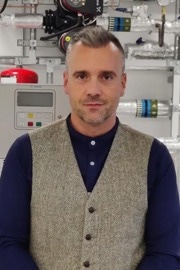Discover how the University of Manchester was able to explore the dynamics of complex proteins thanks to Bruker's groundbreaking technology.
Can you please introduce yourself and your current role?
My name is Christos Pliotas, and I am a researcher in structural biological electron paramagnetic resonance (EPR) spectroscopy at the School of Biological Sciences, University of Manchester. My research involves investigating integral membrane proteins using state-of-the-art EPR methodologies and other structural techniques, such as cryo-electron microscopy.
I have been working in EPR since my Ph.D., as the technique fascinated me by providing access to the microcosm of protein systems and enabling the use of biophysical and spectroscopic tools to address fundamental biological questions.
Can you explain how EPR enables you to achieve different results compared to other analytical methods?
A unique aspect of EPR methodology is that it allows us to understand the dynamics of complex proteins. Beyond static images, it is essential to understand protein motions to interpret their function.
EPR enables us to monitor the conformational ensembles of these proteins and their oligomeric states, which are crucial for assembling these complexes. EPR is unique because it allows scientists to detect signals from engineered spin centers within these proteins through a method called spin labeling.
EPR is instrumental in allowing us to measure distances within a multimeric system, particularly in the mechanosensitive channel of small and large conductance that we are investigating in our lab. This technique enabled us to observe conformational changes upon membrane tension application with angstrom-level resolution, which is crucial for detecting minute helical movements in these significant biological systems.
Our current EPR instrument is a newly installed ELEXSYS E580Q spectrometer from Bruker. We worked closely with Bruker on the installation and setup of this instrument, from detailed planning through to installation, team training, and testing. The process was smooth and comprehensive, which was essential for integrating such a complex analytical tool into an already busy lab.
ELEXSYS E580Q Spectrometer Installation, BioEmPiRe Centre for Structural Biological EPR Spectroscopy
Watch the full interview here
How do you plan to expand on your work with mechanosensitive ion channels? Where does this research fit in relation to the BioEmPiRe research center’s overall goals?
We are currently focused on mechanosensitive ion channels, but we plan to expand in two novel directions.
First, we aim to study other membrane protein classes, such as transporters or receptors. These systems are critical drug targets for diseases like diabetes and cancer. Since the vast majority of the proteins we work on are drug targets, our research could contribute to designing more effective pharmaceuticals and enhancing the efficacy of existing antibiotics.
Second, we hope to extend our EPR measurements into cellular native conditions. At present, we must isolate proteins from their cellular environment to carry out these experiments. In the future, we aim to perform them within intact cells, as EPR can detect signals only from specifically engineered paramagnetic centers within these environments.
Our new UKRI/BBSRC-funded research Centre of Excellence, is devoted to addressing these and other challenging biological applications. We will collaborate with other pulse EPR centers in the UK, such as St. Andrews and Imperial College, in addition to leveraging Manchester’s national facilities. Training the next generation of students and postdoctoral researchers is also a priority to advance progress in the field.
How will the ELEXSYS E580Q spectrometer change your current research capabilities?
The ELEXSYS E580Q spectrometer will significantly enhance the sensitivity of the signals we collect, which is critical for membrane proteins that are typically produced by the cell in small amounts.
We chose the Bruker system because it offers the increased sensitivity and high-resolution capability needed to access various states of protein complexes more effectively. The instrument’s 300-watt amplifier improves our ability to detect signals from lowly expressed membrane proteins, opening up new avenues in protein science.
Could you describe your experience working with Bruker on acquiring and installing the ELEXSYS E580Q spectrometer?
Bruker has been absolutely fantastic. Bruker engineers worked closely with us before and during the installation, ensuring everything was executed efficiently. We could begin setting up experiments almost immediately after installation, which was exciting for us. Bruker personnel were highly professional, providing us with efficient training and support at every step.
For example, we had to consider setting up the chiller on the roof of the Michael Smith building at the University of Manchester prior to the installation. Bruker liaised with the University’s Estates team, technical staff, and engineers to find an efficient solution. The installation process was very swift and smooth, with no unexpected issues.
Regarding training, how has the process of familiarizing everyone with the instrument gone?
The training has been very comprehensive. The individuals who installed the instrument were extremely helpful, providing my team with basic fundamental training during the acceptance test and additional hands-on sessions.
Each member of my lab, including myself, had the chance to operate the system's software and hardware, and we were very satisfied with the experience. The acceptance test confirmed the instrument's high sensitivity, and I was impressed by Bruker's professionalism and expertise.
Now that the instrument is operational, what are you most excited to use it for first?
We will initially conduct tests on samples from previous projects to ensure we achieve the expected signal sensitivity and performance enhancement. Bruker will return in November to confirm these results. Over the next few months, we will focus on optimizing our measurements to meet sample requirements.
Afterward, we will address three primary projects of fundamental importance in membrane protein biology, for which this new instrument will be invaluable. This instrument is a game-changer, and we expect it to allow us to enter an entirely new realm of protein science.
About the Speaker

Christos obtained a BSc in Physics at the University of Athens and an MSc and PhD at the University of Aberdeen. He did his postdoc at the University of St Andrews with James H. Naismith FRS and was subsequently awarded a Royal Society of Edinburgh Fellowship and became a principal investigator at the Biomedical Sciences Research Complex, University of St Andrews. Christos moved to the Astbury Centre for Structural Molecular Biology, at the University of Leeds in October 2018, where he was an Assistant Professor in Integrative Membrane Biology, until May 2023. During his time in Leeds, he received a BBSRC New Investigator Award (2019) and the Sir Robin MacLellan Award for outstanding research funded by Tenovus (2022). As of June 2023 Christos and his lab have moved to the School of Biological Sciences, Faculty of Biology, Medicine and Health, at The University of Manchester, to take up his new post as a Reader in Structural Biological EPR Spectroscopy. As of January 2024, Christos has been elected as a Fellow of the Royal Society of Biology (FRSB) and has been also affiliated with the Manchester Institute of Biotechnology. In Manchester, Christos will launch and direct the new BBSRC-funded BioEmPiRe Centre for Structural Biological EPR Spectroscopy in 2026.
About Bruker BioSpin - NMR, EPR, and Imaging

Welcome to Bruker BioSpin and the world's most comprehensive range of NMR and EPR spectroscopy and preclinical imaging research tools. The Bruker BioSpin Group of companies develop, manufacture and supply technology to research establishments, commercial enterprises and multi-national corporations across countless industries and fields of expertise.
Bruker BioSpin is continuing to revolutionize the design, manufacture and distribution of life science, preclinical, process control and analytical research tools based on magnetic resonance and multimodal imaging technologies. Bruker BioSpin is the worldwide technology and market leader in magnetic resonance technologies (NMR, EPR) and offers the largest portfolio of imaging modalities for preclinical and industrial research under a single brand.